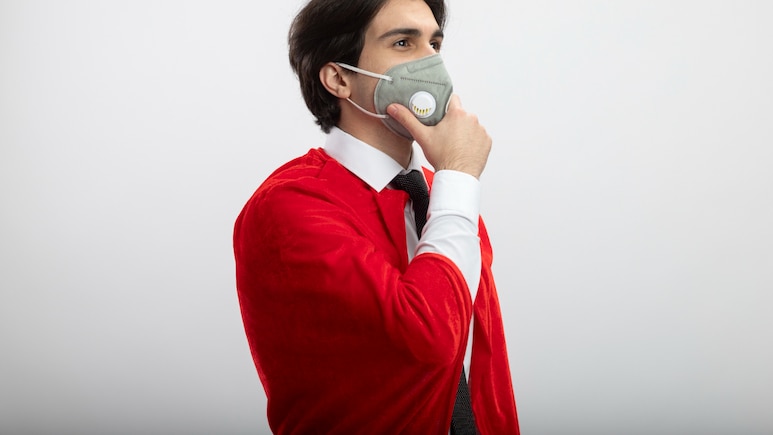
If you live in a city like Delhi, you know all too well how air pollution can turn stepping outside (or even keeping your windows open all day for ventilation) into a health hazard. That's why wearing a mask every day has become second nature for many of us. But did you know that your masks, especially N99 or N95 types, only work if you use them right? A mask that's dirty or worn incorrectly can actually collect bacteria and moisture, putting you at risk instead of keeping you safe. To help you get the best protection, here are some easy, must-follow hygiene tips for making sure your mask really does its job against air pollution.
The Pre-Use Checklist For Mask Hygiene
The pre-use checklist for choosing the right masks is key because of PM2.5 and PM10 particulate matter pollution. Both cloth and surgical masks offer minimal protection against smog and raging air pollution. The main differentiating factor while comparing masks lies in their ability to properly secure the mouth, nose, and correctly conceal the nose. But, make sure it's comfortable as masks need to be worn for long periods.
Inspection
- Before wearing a mask, make sure the filter is clean, as the filter is a barrier for particulate matter.
- Check for tears, holes, or stretched-out elastic bands, as this makes a case for replacing the mask
There are various mask hygiene tips to ensure proper protection from smog and air pollution. These range from choosing which mask to wear, how to store it, and how to dispose of it safely.
Key Mask Hygiene Tips
There are always pre-handling, mid-use, and post-handling of mask hygiene rules that can ensure proper mask hygiene.
- Pre-handling: Always wash or sanitize your hands (for 20 seconds) immediately before wearing your mask.
- Mid-use: Never adjust, remove, or touch the mask's exterior filter material while outside. If you must adjust it, then sanitize your hands first.
- Post-handling: Wash the mask after 3-4 uses if wearing it daily, as the skin produces oils and bacteria that need to be washed off for proper hygiene.
- Seal check: Ensure a tight seal over the nose and chin. Air must pass through the filter, not around from the edges. A poor seal allows polluted air in, defeating the purpose of wearing a mask.
Duration And Contamination Limits For Proper Mask Hygiene
While using masks, the manufacturer's guidelines need to be followed if provided. If no guidelines exist, N95 or N99 masks generally last for 40 hours of extended use. But this is drastically reduced in heavily polluted cities like Delhi, Noida, Faridabad, and Ghaziabad.
The Moisture Test: If the inside of the mask becomes damp (from talking, breathing, or sweating). In addition, if the outside of the mask is visibly dirty, then you need to discard it immediately. This is because damp masks breed bacteria and mold.
What Is The Best Way To Clean Anti-Pollution Masks?
Not all masks are reusable. The masks that you use need to be labelled as reusable, and only then you can use the mask for a longer duration. Be sure to never wash disposable masks with filters, as washing destroys the electrostatic charge that catches PM2.5 and PM10.
Drying:
- If a mask is washable, ensure it is completely air-dried before use, as using a damp mask defeats the purpose of wearing one.
- Do not use dryers or heat, as this can damage the filtering fibers.
How To Store Anti-Pollution Masks
When the mask has been worn for long periods of time, then you are safely removing the mask. This can be done by only touching the ear loops or head straps.
- Avoid touching the front of the mask, as the exterior surface of the mask gets contaminated.
- Immediately sanitize or wash your hands after removal to avoid cross-contamination.
- Follow the paper bag method, store the mask in a clean, open paper bag in-between uses, and keep multiple masks on rotation if they are to be used daily.
- Store the mask in a clean, open paper bag as the paper bag absorbs residual moisture. And the bag protects it from contamination. Do not use plastic containers for storage, as mold or improper discoloration can occur on the surface of the masks.
Responsible Disposal Of Pollution Masks And Maintenance
When discarding a single-use mask, place it in a plastic bag, tie it securely, and dispose of it in a closed dustbin to protect waste pickers from exposure to contaminants.
Masking is your shield, but hygiene is the key to maintaining that shield's integrity. Be diligent, check your mask often, and prioritize clean handling to breathe more safely this pollution season.
Disclaimer: This content, including advice, provides generic information only. It is in no way a substitute for a qualified medical opinion. Always consult a specialist or your doctor for more information. NDTV does not claim responsibility for this information.
Track Latest News Live on NDTV.com and get news updates from India and around the world

